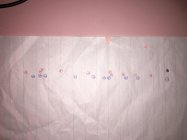Hi mate, you could try something different:
Choose a velocity/ load window of 2 grains
For the same proj weight and case weight, load 20 proj at 0.1 grain increments (ex 1st shot- 45.1, 2nd shot 45.2, 3rd shot 45.3 and so on) and an extra 3 fouling shots.
Set up at the range: chronograph, paper or electronic target and a way to record which shot number in sequence at the target.
Slowly fire each shot in sequence as to not excessively heat up the barrel.
Record the vlocity of each shot.
As you fire, some shots gradually feel that they have less recoil (more of a gentle push) (node) (record the shot number for these) and others feel that the recoil is a kick from a mule (scatter).
After the shoot, you will have two sets of data (velocity and target).
Disregard the fouling shots.
Compare the shot number sequence on the target and get the intervals where they group in elevation.
Compare the shot number sequence where you get a velocity flat spot where the load increases and the velocity barely changes.
You will find that the shot interval for both three types (less recoil, target group and flat spot velocity) are similar.
Pick the load in the middle of the interval and test.
That load is where the barrel is more tolerant to changes in load/ powder batch, it has positive compensation and the third harmonic node is away from the muzzle (check ocw theory).
Hope it helps. It sure helped me every time

Notes: watch out for pressure signs for every shot while you're taking your time between shots (flattened primers, cratered primers and using a magnifying glass to check for gas leakage around the primer where it contacts the primer pocket).
You should find a node every 2 grains or so in a .308. If the node is too fast for what you want, repeat the test with a lower interval by 1.5 grains or even 2 grains.












